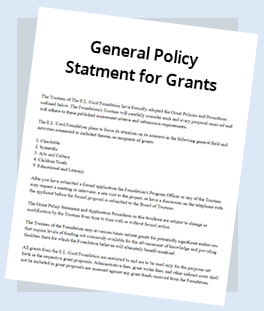The E.L. Cord Foundation Grants
The E.L. Cord Foundation was established December 4, 1962, by E.L. Cord. When Mr. Cord passed away in 1974, under the provisions of his Will, a substantial portion of his Estate was dedicated to The E.L. Cord Foundation to be used for the betterment and well being of mankind. The Foundation is today responsible for enriching the lives of thousands of Northern Nevadans through its generosity in funding all aspects of nonprofit organizations and worthy causes in the community.
Focus Areas for Grants
charitable
scientific
arts and culture
children / youth
educational
General Policy Statement for Grants
The Trustees of The EL Cord Foundation have formally adopted the Grant Policies and Procedures outlined below and also in the downloadable PDF. The Foundation’s Trustees will carefully consider each and every proposal received and will adhere to these published assessment criteria and submission requirements.
I. Applications are accepted on an ongoing basis.
II. The Foundation focuses primarily on organizations in No. Nevada and the rural counties of Nevada.
III. All Applicants must include:
- A concise statement of the project for which funding is sought.
- A statement of the organization’s background and its purpose and objectives. The most recent annual report containing this information will suffice.
- Financial information as follows:
- A copy of the organization’s audited financial statement for its prior fiscal year.
- A copy of the organization’s budget for the current year.
- Most recent unaudited operating and other financial statements available.
- A statement of the organization’s major sources of financial support.
- A statement as to how the applicant and The E.L. Cord Foundation will be able to determine the results of the funded project upon its completion.
- Evidence of tax-exempt status: Copies of documentary evidence of current Federal tax exempt status, i.e., a copy of the organization’s determination letter from the United States Internal Revenue Service stating that the organization is exempt from taxation as an organization defined in Section 501(c)(3) of the Internal Revenue Code and further that the organization is not a private foundation as defined in Section 509(a).
- A list of names of members of the organization’s governing board, showing their business, professional or community affiliations. A Trustee of The E.L. Cord Foundation, who is serving as a Member, Director, Trustee, Officer or employee of an organization which is requesting a grant, will abstain from voting on any matter pertaining to the organization with which the common relationship exists.
- Due to the small size of our staff, materials other than those listed above should not be included. This could delay the application process.
Funding will not be considered for the following requests. Any such request for a grant will be rejected.
- Organizations that do not have a tax-exempt status from the State (if applicable) and Federal governments; or, do not comply with other terms or provisions of the Foundation’s Application Procedures.
- General fund raising events, campaigns, memorial campaigns, deficit funding, conferences or seminars, dinners, or mass mailings.
- Direct aid to individuals.
- Grants to organizations who use funds granted to support other organizations.
- Grants to religious organizations for sectarian purposes.
- Any request that will require permanent or continuing support by the Foundation.
Those characteristics that the Foundation will look for in proposals submitted for consideration will include:
- Exemplary institutions and organizations with a history of achievement and good management.
- Institutions demonstrating a current stable financial condition (supported by current and audited financial statements).
- Programs and projects that produce self-sufficient rather than continuing dependence on the E.L. Cord Foundation support.
- Projects which accomplish a measurable impact in the area and for the purpose for which the applicant requested this grant. The Foundation will each year study and assess the impact of prior grants and will do so during the first quarter of each calendar year while it is developing internally its own programs.

